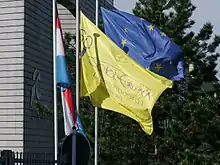European School, Luxembourg I
The European School, Luxembourg I was the first of the European Schools. It was founded in October 1953 on the initiative of officials of the European Coal and Steel Community, with the support of the Community's institutions and the government of Luxembourg. In April 1957, it formally became the first of the European Schools. Today it is located on the Kirchberg-Plateau in Luxembourg City.[3]
| European School, Luxembourg I Schola Europaea | |
|---|---|
 | |
| Address | |

| |
23 Boulevard Konrad Adenauer , L-1115 | |
| Coordinates | 49°37′38″N 6°09′11″E |
| Information | |
| Type | European School |
| Established | 1953 |
| Director | Martin Wedel (Germany)[1] |
| Gender | Mixed |
| Age range | 4 to 18 |
| Enrolment | 3,333[2] (2019-2020) |
| Student Union/Association | The Pupils' Committee |
| Sister Schools | 12 European Schools |
| Diploma | European Baccalaureate |
| Website | www |
History
Boulevard de la Foire
Parents working for the European Coal and Steel Community established the school in 1953.[4] It became necessary to establish a new school when many European children from varying language backgrounds appeared.[5]
When the school was founded it was located on the premises of a former furniture shop in the Limpertsberg quarter of Luxembourg city. It initially had 70 students. The school later moved to Villa Lentz in Hollerich.[4] In 1956 construction began on a new building, located on Boulevard de la Foire, just outside the city centre. The building was opened in 1957,[4] on 11 December. This building today houses the language teaching centre of Luxembourg. The first students graduated in 1959; the graduating class was 23.[4]
At a later date, the school moved to a new site on the Kirchberg plateau, another quarter of Luxembourg city. During the late 80s, the school re-used the building at Boulevard de la Foire, as an overflow school for three age groups of the primary school. Since the end of the 1990s, the old building at Boulevard de la Foire has no longer been used by the European School.
Kirchberg
The school progressively moved to Kirchberg in the 1990s.[4] At the end of the 1990s, the grounds on Kirchberg were completely redesigned. Old buildings were demolished and new ones (e.g. a new primary school building, an extension of the secondary school building and a new theatre building) were built, though three blocks of the old Secondary school (the current A, B and C blocks) were left standing. T and L blocks were added due to high number of students. In 2012, the school relocated a large portion of students to a second European School of Luxembourg campus, situated in Mamer. 3 years after the separation, it was decided that only T block will be conserved, while L is due to be demolished.
In 2014 the Luxembourgish government signed an agreement for the European Schools to accept 100 more students in their English and French sections.[6]
Notable alumni
- Eric Everard – founder and CEO of Artexis Group
- Marc Hostert – radio personality
- Princess Margaretha of Liechtenstein – second daughter of the Grand Duke of Luxembourg
- Elizabeth May – Olympic triathlete
- Brian Molko – lead singer, songwriter and guitarist of Placebo (transferred prior to graduation)
References
- http://www.euroschool.lu/esluxone/Documents/Home/News/2017/20170901-Message-de-Monsieur-Wedel/Texte%20de%20presentation%20Martin%20Wedel_Site_LUX1FR.pdf
- Board of Governors of the European Schools. "Facts and figures on the beginning of the 2019-2020 school year in the European Schools" (PDF). eursc.eu. Office of the Secretary-General of the European Schools. p. 2. Retrieved 2 July 2020.
- "Schola Europaea". EURSC. Archived from the original on 10 March 2009. Retrieved 26 January 2009.
- "European school thanks Luxembourg for 60 great years". Luxemburger Wort. 8 April 2013. Archived from the original on 29 May 2016. Retrieved 31 May 2016. ()
- Heusch, Albert (Luxembourg). "Die Europäische Schule in Luxemburg." Archiv des Völkerrechts, Mohr Siebeck GmbH & Co. KG, 8. Bd., No. 1 (July 1959), pp. 71-86. CITED: p. 71. "Nach dem Inkrafttreten des Vertrages über die Gründung der Europäischen Gemeinschaft für Kohle und Stahl (23. Juli 1952) nahmen die Bediensteten der neuen Institution mit ihren Familien Wohnsitz in Luxemburg. Bald zeigte sich das Schulproblem in seiner ganzen Dringlichkeit. Schon aus sprachlichen Gründen kam eine allgemeine Integration aller Schüler aus fünf Nationen mit verschiedenen Muttersprachen in die luxemburgischen Unter- richtsinstitute nicht in Betracht."
- "European Schools to accept more French and English students" ( Archived 29 May 2016 at the Wayback Machine). Luxemburger Wort. Monday 19 May 2014. Retrieved on 30 May 2016.